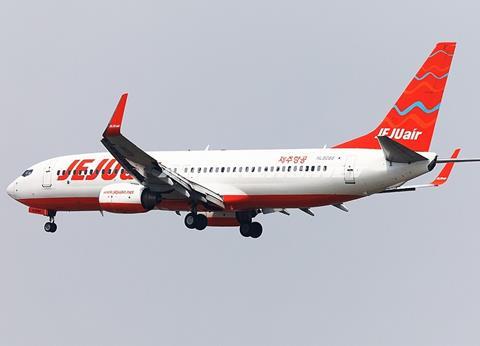Korean investigators have confirmed that evidence of bird-strike was found in both engines of the Jeju Air Boeing 737-800 involved in the fatal landing accident at Muan airport.
The inquiry has identified feathers and other debris as belonging to the Baikal teal, a species of east Asian duck which typically weighs 400g.
It expects to release preliminary findings on 27 January but the transport ministry has disclosed initial details about the 29 December crash obtained by the investigation.
Three minutes after making contact with tower controllers, who subsequently granted landing clearance for runway 01, the crew was warned of bird activity.
Shortly afterwards, the pilots remarked about the presence of birds below the aircraft. Some 40s later – and 1min after the tower waring – the cockpit-voice and flight-data recorders “simultaneously stopped”, the ministry says. At this point the aircraft’s altitude was just below 500ft and it was travelling at 161kt.
The crew declared an emergency, due to bird-strike, to the tower as they began executing a missed approach.

During this go-around, the aircraft flew along the left side of the runway. Rather than rejoining the circuit, the crew carried out a right turn in a bid to land on the opposite-direction runway 19.
The aircraft approached the runway “squarely”, says the ministry, but landed without its landing-gear deployed.
It overran after the touchdown and, 4min after the ‘Mayday’ call, collided with the localiser antenna mount. The impact destroyed the aircraft and left just two survivors from the 181 occupants.
Surveillance cameras at the airport captured the contact with birds and investigators discovered blood and feathers in both CFM International CFM56 engines, the ministry states. The remains underwent genetic analysis.
“It is not possible to determine the number of birds, or whether [the remains] include other types of birds,” the ministry says, adding that the engines will be disassembled for further inspection.
The inquiry will have to establish the cause of the crash without full information from the flight recorders, which ceased operating for the final 4min 7s of the accident sequence.
It will carry out a thorough examination of the wreckage – which has been transferred to a hangar at Muan – with detailed analysis of certain debris being conducted at Gimpo airport.
The data available from the flight recorders is being synchronised with air-ground communiations and other information in order to ascertain the operational status of the 737, and determine the extent of any external influence on, or abnormality with, the aircraft and its engines.
“It is expected that several months of detailed analysis and verification will be required,” the ministry says.
Investigators will need to explain several aspects of the accident, including the crucial the decision to attempt an opposite-direction landing.
Confirmation of bird debris in both engines could indicate a loss of thrust, and consequently limited inability to climb or even maintain height, leaving the crew with the choice between an urgent turnback or a possible ditching in the surrounding waters.
Although an opposite-direction landing potentially brings the risk of tailwind, and increased groundspeed, the ministry’s briefing states that Muan was experiencing crosswinds from the east at the time.
The ministry has not given details of the height and speed achieved by the aircraft during its go-around.
Simultaneous recorder cut-out points to a loss of electrical power generated by the engines, although this has yet to be confirmed, along with whether the aircraft also lost hydraulic power to any extent.
The jet should have had its flaps extended and landing-gear deployed for approach prior to the bird-strike. Normal go-around procedures would have involved establishing positive climb, raising the landing-gear and incrementally retracting the flaps.
But the aircraft did not have its landing-gear extended during the approach to runway 19, while its flaps also appear retracted. The inquiry has yet to establish the reasons for these observations, and whether they were the result of crew actions – intentional or otherwise – or system failures.
Muan’s runway 19 is about 2,800m in length. The precise distance along the runway, and the aircraft’s speed, at touchdown are among details yet to be confirmed.


























